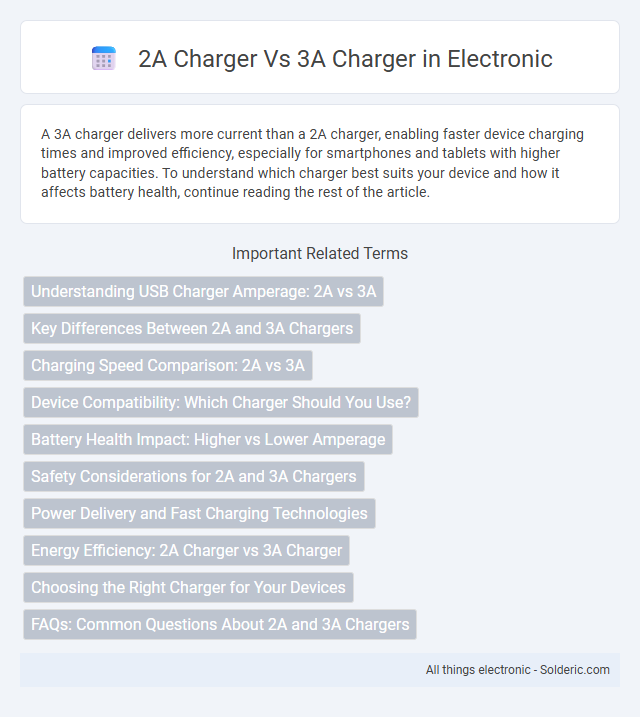A 3A charger delivers more current than a 2A charger, enabling faster device charging times and improved efficiency, especially for smartphones and tablets with higher battery capacities. To understand which charger best suits your device and how it affects battery health, continue reading the rest of the article.
Comparison Table
| Feature | 2A Charger | 3A Charger |
|---|---|---|
| Charging Current | 2 Amperes | 3 Amperes |
| Charging Speed | Slower | Faster |
| Power Output | Typically 10 Watts (5V x 2A) | Typically 15 Watts (5V x 3A) |
| Device Compatibility | Compatible with most smartphones, tablets | Better for devices supporting fast charging |
| Heat Generation | Lower heat output | Higher heat output, requires good thermal management |
| Cable Requirement | Standard USB cables | High-quality cables for optimal performance |
| Use Case | Everyday charging needs | Fast charging, power-hungry devices |
Understanding USB Charger Amperage: 2A vs 3A
A 2A USB charger delivers 2 amperes of current, which is suitable for charging most smartphones and smaller devices efficiently, while a 3A charger provides 3 amperes, enabling faster charging for tablets, newer smartphones, and power-hungry gadgets. Higher amperage chargers like 3A support quicker battery fill rates without exceeding device limits due to built-in current regulation. Choosing between 2A and 3A chargers depends on device compatibility and charging speed requirements, with 3A chargers benefiting devices that support fast charging standards such as USB Power Delivery or Qualcomm Quick Charge.
Key Differences Between 2A and 3A Chargers
A 2A charger delivers a maximum current of 2 amperes, while a 3A charger supplies up to 3 amperes, impacting charging speed and device compatibility. Devices with larger batteries or fast-charging technology benefit from 3A chargers due to their higher current capacity, which reduces charge time significantly. However, using a 3A charger with devices designed for 2A may not increase charging speed and could potentially cause overheating if the device's circuitry is not compatible.
Charging Speed Comparison: 2A vs 3A
A 3A charger delivers 50% more current than a 2A charger, resulting in significantly faster charging speeds for compatible devices. Your device will reach optimal battery levels quicker with a 3A charger, especially when supported by USB Power Delivery or similar fast-charging standards. However, actual charging speed also depends on the device's charging circuitry and battery capacity.
Device Compatibility: Which Charger Should You Use?
A 3A charger delivers more current than a 2A charger, making it ideal for devices with larger batteries or those supporting fast charging technologies such as USB Power Delivery or Qualcomm Quick Charge. Using a 2A charger on devices designed for 3A charging may result in slower charging times, whereas a 3A charger can safely provide power to devices requiring less current without damaging them. Your choice should depend on your device's maximum charging input to ensure optimal charging efficiency and battery longevity.
Battery Health Impact: Higher vs Lower Amperage
A 2A charger delivers a moderate current that helps maintain your battery's health by reducing heat generation and minimizing stress during charging. In contrast, a 3A charger provides higher amperage, which can speed up charging times but may increase heat and potentially shorten battery lifespan if used frequently or with incompatible devices. Choosing the right amperage charger ensures optimal balance between charging speed and preserving your battery's long-term performance.
Safety Considerations for 2A and 3A Chargers
When comparing 2A and 3A chargers, safety considerations primarily revolve around current capacity and heat management. A 3A charger supplies higher current, potentially charging devices faster but increasing the risk of overheating if the device or cable is not rated for that capacity. Ensuring your charger matches your device's specifications helps prevent electrical hazards and prolongs battery health.
Power Delivery and Fast Charging Technologies
A 3A charger delivers higher current than a 2A charger, enabling faster power delivery to compatible devices and reducing overall charging time. Fast charging technologies like USB Power Delivery (PD) benefit significantly from increased amperage, allowing your smartphone or laptop to reach a higher charge capacity quickly. Choosing a 3A charger ensures improved efficiency and compatibility with advanced fast charging standards compared to a 2A charger.
Energy Efficiency: 2A Charger vs 3A Charger
A 2A charger typically delivers lower current, resulting in slower charging times but often greater energy efficiency due to reduced heat generation and lower power loss. In contrast, a 3A charger provides faster charging by supplying higher current, which can increase energy consumption and heat, potentially reducing overall efficiency. Energy efficiency depends on device compatibility and charging protocols, with smart chargers optimizing power delivery to balance speed and minimal energy waste.
Choosing the Right Charger for Your Devices
Choosing the right charger depends on your device's power requirements, with a 2A charger typically suitable for smartphones and smaller gadgets, while a 3A charger better supports tablets and faster charging needs. Using a charger with insufficient amperage may result in slower charging times and potential battery strain, whereas a higher amperage charger can optimize performance without exceeding device limits. Always check your device's specifications to ensure compatibility and maintain battery health.
FAQs: Common Questions About 2A and 3A Chargers
2A chargers typically deliver 10 watts of power, which is sufficient for charging smartphones and smaller devices at a moderate speed, while 3A chargers provide up to 15 watts, enabling faster charging for compatible devices. Common questions include compatibility with devices, impact on battery health, and charging speed differences. Users often want to know if using a 3A charger will damage their device or if a 2A charger is too slow, with experts confirming that modern devices regulate power intake to prevent damage regardless of charger amperage.
2A charger vs 3A charger Infographic

 solderic.com
solderic.com